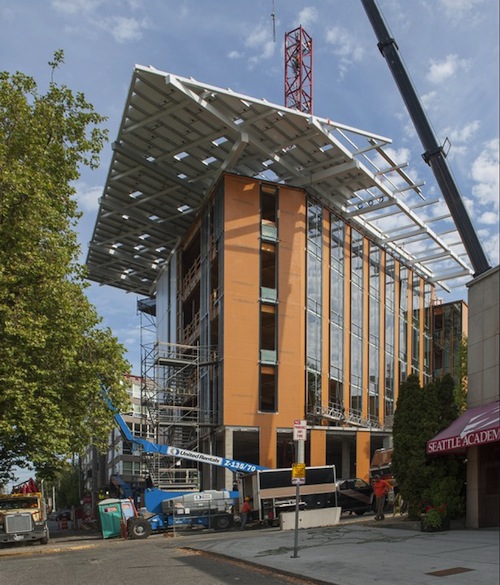Seattle’s Bullitt Center, a project of the Bullitt Foundation, has been designed to be the most energy efficient commercial building on the planet and put Seattle on “the forefront of the green building movement,” according to the project’s website.
With the first floor already leased to the International Living Future Institute and the University of Washington Integrated Design Lab, the remaining five floors of this 50,000-sf green building are now available to lease in advance of its planned opening this spring.
The Bullitt Center expects to achieve the goals of the Living Building Challenge (v2.0), the world’s most strenuous sustainability benchmark. Certification requires a structure to be energy and water self-sufficient for 12 consecutive months and meet 20 imperatives within seven “Petals,” or performance areas.
Petal One – Site: The location supports lifestyle that is friendly to pedestrians, bicycles, and public transit.
Petal Two – Water: Rainwater is collected on the roof and stored underground to be used building-wide.
Petal Three – Energy: The solar array will produce sufficient electricity for the building’s tenants.
Petal Four – Health: Promoting health for the building’s occupants, it features stairways that are pleasing alternatives to elevators, operable windows, and facilities that encourage occupants to walk and share resources.
Petal Five – Materials: The Bullitt Center will not contain hazardous materials from the “Red List,” such as PVC, lead, cadmium, mercury, or hormone-mimicking substances.
Petal Six – Equity: Fresh air and daylight will be available to all workers and the construction team has been selected using the Community High Road Agreement as enacted by the city of Seattle.
Petal Seven – Beauty: The architecture has been designed to help beautify the surrounding area, including a green roof, large structural timbers, native plants, an innovative photovoltaic array, and a revitalized neighboring pocket park.
The Building Team for the $30 million facility includes architect Miller Hull Partnership and contractor Schuchart, as well as Point32, PAE Consulting Engineers, Luma Lighting Design, 2020 Engineering, and Berger Partnership.
(http://www.jetsongreen.com/2013/03/the-worlds-greenest-commercial-building-now-leasing-for-spring-2013-opening.html)
Related Stories
Higher Education | Aug 7, 2023
Building a better academic workplace
Gensler's David Craig and Melany Park show how agile, efficient workplaces bring university faculty and staff closer together while supporting individual needs.
University Buildings | Aug 7, 2023
Eight-story Vancouver Community College building dedicated to clean energy, electric vehicle education
The Centre for Clean Energy and Automotive Innovation, to be designed by Stantec, will house classrooms, labs, a library and learning center, an Indigenous gathering space, administrative offices, and multiple collaborative learning spaces.
Green | Aug 7, 2023
Rooftop photovoltaic panels credited with propelling solar energy output to record high
Solar provided a record-high 7.3% of U.S. electrical generation in May, “driven in large part by growth in ‘estimated’ small-scale (e.g., rooftop) solar PV whose output increased by 25.6% and accounted for nearly a third (31.9%) of total solar production,” according to a report by the U.S. Energy Information Administration.
Resiliency | Aug 7, 2023
Creative ways cities are seeking to beat urban heat gain
As temperatures in many areas hit record highs this summer, cities around the world are turning to creative solutions to cope with the heat. Here are several creative ways cities are seeking to beat urban heat gain.
Government Buildings | Aug 7, 2023
Nearly $1 billion earmarked for energy efficiency upgrades to federal buildings
The U.S. General Services Administration (GSA) recently announced plans to use $975 million in Inflation Reduction Act funding for energy efficiency and clean energy upgrades to federal buildings across the country. The investment will impact about 40 million sf, or about 20% of GSA’s federal buildings portfolio.
MFPRO+ New Projects | Aug 4, 2023
Nashville gets 'first-of-its-kind' residential tower
Global architecture firm Goettsch Partners announces the completion of Alcove, a new 356-unit residential tower in Nashville, Tenn., developed by Giarratana LLC.
Industrial Facilities | Aug 3, 2023
The state of battery manufacturing in the era of EV
One of the most significant changes seen in today’s battery plant is the full manufacturing process—from raw materials to the fully operational battery.
Government Buildings | Aug 2, 2023
A historic courthouse in Charlotte is updated and expanded by Robert A.M. Stern Architects
Robert A.M. Stern Architects’ design retains the original building’s look and presence.
Hotel Facilities | Aug 2, 2023
Top 5 markets for hotel construction
According to the United States Construction Pipeline Trend Report by Lodging Econometrics (LE) for Q2 2023, the five markets with the largest hotel construction pipelines are Dallas with a record-high 184 projects/21,501 rooms, Atlanta with 141 projects/17,993 rooms, Phoenix with 119 projects/16,107 rooms, Nashville with 116 projects/15,346 rooms, and Los Angeles with 112 projects/17,797 rooms.
Architects | Aug 1, 2023
Ware Malcomb announces hire of Jason Golub as Regional Director
In this role, Golub is responsible for the overall leadership and continued growth of the office.

















